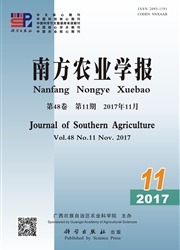

 中文摘要:
中文摘要:
【目的】分离鉴定番茄青枯病的病原菌,并分析其生物学特性,以期为番茄青枯病防治和番茄抗青枯病育种提供理论基础。【方法】采用平板稀释法从番茄青枯病株中分离得到病原菌,并对分离菌株的16S r DNA序列、碳水化合物利用、致病性、演化型及序列变种等进行分析。【结果】从感染了青枯病的番茄植株中分离到9个菌株Tom 1-Tom 9,根据分离菌株在TTC培养基上的菌落形态、致病性测定和分子鉴定,将9个菌株鉴定为茄科雷尔氏菌(Ralstonia solanacearum);9个分离菌株可以利用3种双糖和3种己醇,并可侵染烟草、马铃薯、番茄、辣椒和茄子;9个分离菌株均可同时扩增得到144 bp的演化型Ⅰ的特异条带和280 bp的青枯菌特异条带。【结论】从感病番茄植株中分离得到的9个菌株为茄科雷尔氏菌(Ralstonia solanacearum),属于生化型Ⅲ、生理小种1、演化型Ⅰ和序列变种17。
 英文摘要:
英文摘要:
[Objective]The pathogen separation and molecular identification of the infected tomato plants were conducted and the biological characteristics were analyzed to provide theoretical references for breeding the resistant varieties and controlling the tomato bacterial wilt. 【Method】Ralstonia solanacearum strains were isolated using the plate dilution method, and the 16 S r DNA sequence, carbohydrate utilization, pathogenicity, phylotype and sequevar of the strains were studied. 【Result】Strains Tom 1-Tom 9 isolated from tomato plants were identified as Ralstonia solanacearum based on the results of colony characteristics on TTC medium, pathogenicity inoculation test and molecular identification. The result of carbohydrate utilization and pathogenicity tests showed that the 9 strains were able to oxidize three hexoses and three disaccharides, and could strongly infect tobacco, potato, tomato, pepper and eggplant. The results of phylotype multiplex PCR indicated the specific 280 and 144 bp bands were amplified from all 9 strains, respectively.【Conclusion 】Nine strains of Ralstonia solanacearum isolated from tomato infected with bacterial wilt has been identified and belong to biovar Ⅲ, race 1, phylotype Ⅰ and sequevar 17.
 同期刊论文项目
同期刊论文项目
 同项目期刊论文
同项目期刊论文
 期刊信息
期刊信息
